The history of
No. 1 model
is going back as far as the history of Millers Falls
company. Over the years Millers Falls
Company released numerous No. 1 drill variations. Some of
them are a subject of this presentation. Whenever possible
I use verbatim description from available catalogs.
The earliest description of this drill I
am in possession of is from
reprint of the Millers Falls Catalog dated 1878. The catalog lists four
variations of this early model:
Hand Drill No. 1

-
Hand Drill No. 1 - Single Gear,
holds 1/32 to 1/8 Drills.
-
Hand Drill No. 1A - Single
Gear, hollow handle, nickel plated.
-
Hand Drill No. 1B - Double
Gear, same chuck.
-
Hand Drill No. 1C - Double
Gear, hollow handle, plated.
Six Drill Points with each of the
above Drill Stocks
These
Drill Stocks are made of malleable iron, with steel
spindle and rosewood head and handle. The jaws are
forged steel and will hold perfectly any size Drills
named above. They are the only Drill Chucks in use
which will hold such a variety of Morse Twist Drills.
In 1899 the Central Electric Company from Chicago, Il.
released a General Catalog with various tools for
electricians. Among them the Millers Falls No. 1
hand drill is listed with different chuck.
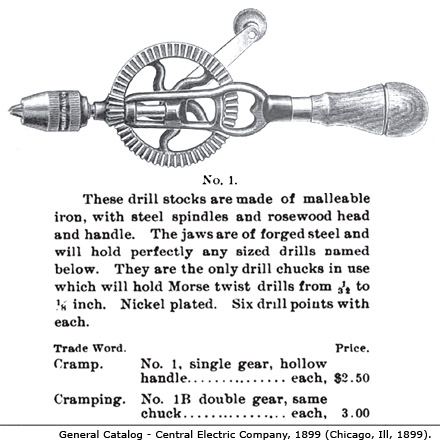
By 1903 new design was introduced that completely
departed from original seen above. In later years
several
minor changes were introduced throughout the years but basic
design however, introduced around 1903 stayed the same.
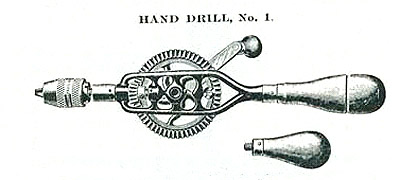
From 1903 catalog:
"These Drills are provided with
Chucks having three jaws resting in solid socket. There
are no springs to get out of place or out of order. The
chucks are nickel-plated and the handles made in Cocobolo. They hold
drills from 0 to 3/16. A side handle, as shown in cut, is
furnished with this drill.
Price per dozen, including 8 fluted
points in hollow handle ...... $15.00"
First, the frame was completely redesigned. It was made of
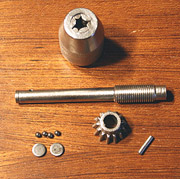 malleable
iron with massive compartment to hold Ball Thrust Bearing
at the end of the spindle. There is no clear statement in
1903 catalog about this distinguishing feature and I base this
statement on my own detailed study
of many specimens of No. 1 hand drill
- "model 1903", including disassembling drills to the smallest
components. In all instances the drills had
a ball bearings consisting of 2 round plates and 4 steel
balls between them.
malleable
iron with massive compartment to hold Ball Thrust Bearing
at the end of the spindle. There is no clear statement in
1903 catalog about this distinguishing feature and I base this
statement on my own detailed study
of many specimens of No. 1 hand drill
- "model 1903", including disassembling drills to the smallest
components. In all instances the drills had
a ball bearings consisting of 2 round plates and 4 steel
balls between them.
I also
reviewed all available catalogs, including editions from
1878, 1886, 1887, 1903, 1915 and later. It is true
that the first mention of Ball Thrust Bearing appears in
catalog No. 35 from 1915. However, available
catalogs can not be treated as an ultimate and solid
source of information about the design and features of
Millers Falls tools. There are too many
inconsistencies, omissions and vague statements.
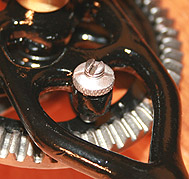
The other
distinguishing feature was employment of an
equalizing friction screw with a lock nut
instead of second pinion used on models No. 1B and No.
1C prior to 1903. The catalog from 1903 shows this
new element, but no comment is included in the
description. This important design feature
survived in all consecutive editions of No. 1 hand drill
known to me.
The last significant element introduced in this design was a
Spring-less Chuck patented by William H. McCoy. The
patent was issued on September 29, 1896 with number 568,539.
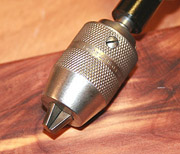 The
patent and production rights were assigned to Millers Falls
Company. All No. 1 drills examined for this presentation
and produced before 1925 are equipped with this chuck. By
1925 new spring chuck was introduced on most of the Millers
Falls drills. This new chuck was designed and patented by Henry A. Ryther. The patent was issued on
October 9, 1923
with a number
1,470,197. The patent and production
rights were assigned to Millers Falls Company.
The
patent and production rights were assigned to Millers Falls
Company. All No. 1 drills examined for this presentation
and produced before 1925 are equipped with this chuck. By
1925 new spring chuck was introduced on most of the Millers
Falls drills. This new chuck was designed and patented by Henry A. Ryther. The patent was issued on
October 9, 1923
with a number
1,470,197. The patent and production
rights were assigned to Millers Falls Company.
The
production of this model continued into 1940s.